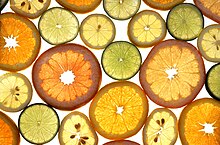The generic name originated in Latin, where it specifically referred to the plant now known as Citron (C. medica). It was derived from the ancient Greek word for cedar, κέδρος (kédros). Some believe this was because Hellenistic Jews used the fruits of C. medica during Sukkot (Feast of the Tabernacles) in place of a cedar cone,[4] while others state it was due to similarities in the smell of citrus leaves and fruit with that of cedar.[5] Collectively, Citrus fruits and plants are also known by the Romance loanword agrumes (literally "sour fruits").
The taxonomy and systematics of the genus are complex and the precise number of natural species is unclear, as many of the named species are hybrids clonally propagated through seeds (by apomixis), and there is genetic evidence that even some wild, true-breeding species are of hybrid origin.[6] Cultivated Citrus may be derived from as few as four ancestral species. Natural and cultivated origin hybrids include commercially important fruit such as the oranges, grapefruit, lemons, some limes, and some tangerines.
Research suggests that the closely related genus Fortunella (kumquats), and perhaps also Poncirus and the Australian Microcitrus and Eremocitrus, should be included in Citrus; most botanists now classify Microcitrus and Eremocitrus as part of the genus Citrus.[7] Two additional genera: Triphasia and Clymenia are likewise very closely related, and bear hesperidium fruits, but are not considered part of the Citrus genus. At least one, Clymenia, will hybridize with kumquats and some limes.
Description

Citrus fruits are notable for their fragrance, partly due to flavonoids and limonoids (which in turn are terpenes) contained in the rind, and most are juice-laden. The juice contains a high quantity of citric acid giving them their characteristic sharp flavour. The genus is commercially important as many species are cultivated for their fruit, which is eaten fresh, pressed for juice, or preserved in marmalades and pickles.
They are also good sources of vitamin C and flavonoids. The flavonoids include various flavanones and flavones.[10]
Tidak ada komentar:
Posting Komentar